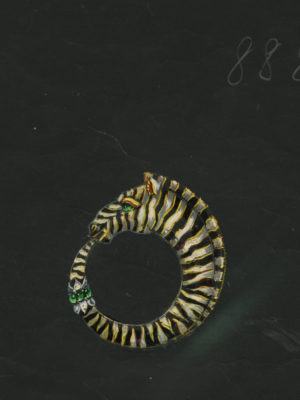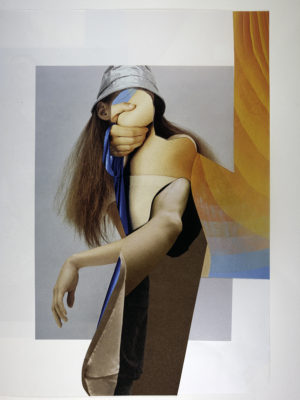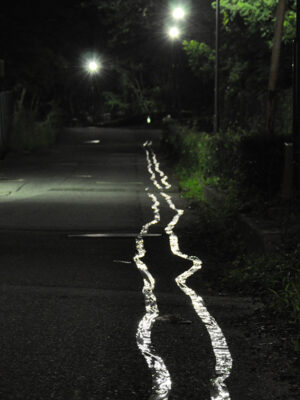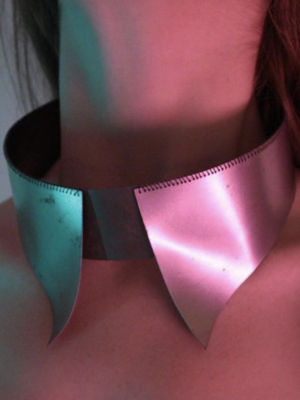Early on, David Webb met and aligned with a French woman named Antoinette Quilleret, who provided financial backing and significant social entry for his jewelry. With that partnership, in 1948 David Webb Inc. was born, and he began to supply jewelry to Bergdorf Goodman, B Altman, and others. Within two years of founding his business, David Webb found his jewelry on the cover of Vogue, catapulting his company into the limelight of the fashion scene. Ms Quilleret assisted him with introductions, and soon the toast of Manhattan society was eager to begin their own David Webb jewelry collections.
___STEADY_PAYWALL___
The company swiftly grew in the coming years and, as jewelry styles changed and evolved, David Webb’s work truly came into its own. In the fifties his work was reliable and wearable, but by the sixties he was experimenting more with developing his own design vocabulary—a vocabulary that continues to define the David Webb style to this day. Big, bold, powerful designs with musculature and definition enveloped this newfound lexicon. Creating all his jewelry in-house, he became known for his expertise in enameling, texturing and hammering gold, and daring color combinations with distinctive gemstones. These artistic choices attracted clients from all over the world to travel to David Webb’s Manhattan boutique.
In 1964, David Webb won the Coty American Fashion Critics’ Award for Accessories, making him the first American fine jeweler to receive the honor. The awards were held at The Metropolitan Museum of Art, one of David Webb’s favorite institutions. Milton Greene and Joe Eula created a film reel for the occasion titled “A Walk in the Woods” that projected David Webb’s animal jewelry in a revolutionary and artistically experimental way. His unique representation of animals in enamel, diamonds, and colorful gemstones was a striking sensation.
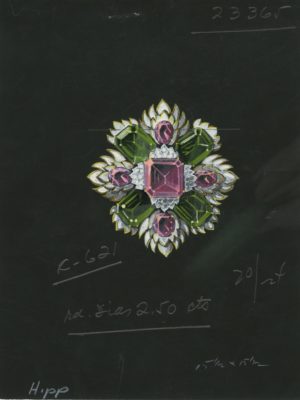
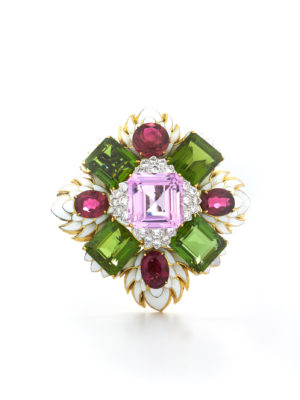
As animals began to fill his oeuvre, David Webb’s Manhattan boutique became a go-to destination for American and international socialites alike. His signature enameled black-and-white zebra bracelet was a crowd-pleaser, and still possibly the most popular David Webb animal bracelet. Editor and fashion giant Diana Vreeland owned one of the famed zebra bracelets, and during her time at Vogue, she oversaw celebrated photographer Irving Penn as he shot a graphic black-and-white enameled David Webb zebra ring for the cover, with the model donning matching striped eye makeup. Expanding the collection, David Webb added other animals into the assortment—there were wild jungle cats, as well as lucky green frogs, beautifully patterned giraffes, and graceful gold elephants.
Beyond his fascination with animals, David Webb was a designer who adored exploring his references. He was constantly inspired by his weekly trips to the legendary Met Museum to see the ancient crafts and worldly cultures, and his personal reference library was rich with books on Chinese jade, Egyptian and Peruvian art, and other peculiarities, as well as an extensive encyclopedia of knots and fancy rope work. These ancient cultural influences continue to play an important role in the jewelry created at David Webb today.
In 1963, David Webb penned an article for the New York Herald Tribune entitled “Why Not Hang Gems?” In it, he expounded on the idea that jewelry is just as noteworthy as sculpture or paintings and should be displayed in museums to be appreciated by the public. He wrote that “jewels should be treated as great works of art.”
Since it was established, David Webb jewelry has been made in America—first in his workshop on Jewelers’ Row on 47th Street and, presently, in the house workshop above the New York flagship boutique on Madison Avenue. The workshop is integral to the foundation of David Webb and is now filled with craftsmen from second- and third-generation jewelers. Amid the hissing steam and buzzing drills, the workshop is alive with the DNA of David Webb that dates back to its founding. The current foreman has been at David Webb since 1979, and the workshop’s polisher joined the company in 1965. Their extensive knowledge and experience with David Webb’s inimitable artistry is fundamental to the brand’s heritage and legacy.
Today, David Webb’s creative ethos draws from a vast and rich language, resulting in pieces that are wearable art, meant to be worn, not kept in a vault. Etruscan-style gold hammering is an ancient reference, but the look of the hand-hammered 18K yellow gold couldn’t feel more modern. Other unique design domains that distinguish David Webb include glittering rock crystal, carved coral and jade, Maltese crosses, geometric patterned enamel, and the iconic nail.
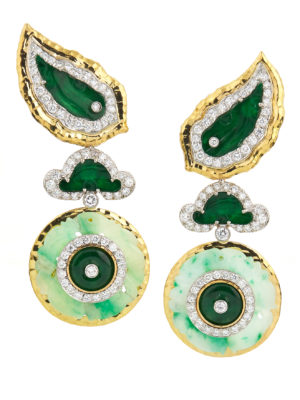
In December 1975, David Webb passed away at age 50 from pancreatic cancer. Leaving behind over 50,000 original jewelry drawings, designs, and molds, the archives continue to inspire the design lexicon of David Webb. The hand-painted archival renderings are testaments to the art that is jewelry-making.
David Webb remains a major force in the world of fashion and high luxury jewelry. The company is currently owned by Mark Emanuel and Robert Sadian, who ensure that David Webb’s design vision still pulses through the work that the jewelers create today. Mark Emanuel states, “We are tremendously proud of our founder and our brand’s heritage. Through David Webb’s relatively brief career, we witness the evolution of a young designer to a mature modern master. His fiercely imaginative mind constantly trailblazed the American style, and from his studio came world-renowned gems and jewelry that stands the test of time.”
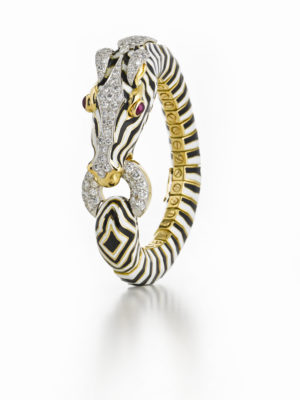
This article was first published in the #6 Current Obsession Paper for New York City Jewelry Week
